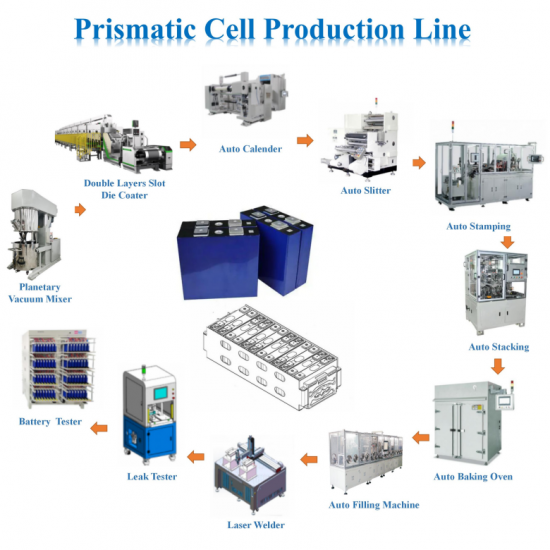Lith Corporation, founded in 1998 by a group of material science doctor from Tsinghua University, has now become the leading manufacturer of battery lab&production equipment. Lith Corporation have production factories in shenzhen and xiamen of China.This allows for the possibility of providing high quality and low-cost precision machines for lab&production equipment,including: roller press, film coater,mixer, high-temperature furnace, glove box,and complete set of equipment for research of rechargeable battery materials. Simple to operate, low cost and commitment to our customers is our priority.
What is an EV Car Battery Production Plant?
An EV (Electric Vehicle) Car Battery Production Plant is a largescale industrial facility dedicated to the design, manufacturing, and integration of lithiumion battery systems for electric vehicles. It encompasses entire battery production ecosystems, including:
Battery cell fabrication lines
Module and pack assembly lines
Material storage and handling systems
Quality control and testing labs
Battery Management System (BMS) development and integration
Supporting infrastructure (e.g., clean/dry rooms, fire suppression, utilities)
These plants are often referred to as Gigafactories when they reach a gigawatthour (GWh) scale of annual output — capable of producing enough batteries for hundreds of thousands of EVs each year.
Such plants are critical for:
Automotive OEMs (e.g., Tesla, BMW, Ford, Rivian) seeking vertical integration
Battery manufacturers (e.g., CATL, LG Energy Solution, Panasonic, BYD)
New energy startups building domestic supply chains
Governments and industrial zones aiming to localize EV production
Key Objectives of an EV Battery Production Plant
1. Mass Production of Battery Systems
Manufacture highquality battery cells, modules, and packs at scale
Meet automotivegrade performance, safety, and reliability standards
2. Localization of Battery Supply Chain
Reduce dependency on imports and global logistics bottlenecks
Support local EV manufacturing and job creation
3. Integration of Advanced Technologies
Adopt new battery chemistries (e.g., solidstate, sodiumion)
Implement dry electrode coating, AIdriven quality control, and smart manufacturing
4. Cost Reduction and Economies of Scale
Lower battery cost per kWh through automation, process optimization, and vertical integration
Enable competitive EV pricing and faster adoption
5. Sustainability and Circular Economy
Incorporate recycling systems for endoflife batteries
Use renewable energy and green manufacturing practices
Core Components of an EV Battery Production Plant
A modern EV battery production plant typically includes the following integrated zones:
1. Battery Cell Fabrication Area
Houses the full cell production line from slurry mixing to final cell testing
Includes:
Slurry preparation and coating
Electrode drying and calendering
Stacking or winding
Electrolyte filling and sealing
Formation, aging, and testing
2. Module and Pack Assembly Area
Integrates individual cells into battery modules and then into complete battery packs
Includes:
Cell sorting and matching
Module stacking and welding
Thermal interface material (TIM) application
BMS installation and integration
Pack enclosure and sealing
3. Battery Testing and Validation Lab
Conducts electrical, mechanical, and safety testing on cells, modules, and packs
Performs:
Charge/discharge cycle testing
Thermal stability and abuse testing
BMS functional validation
Environmental stress testing (vibration, humidity, temperature extremes)
4. Battery Management System (BMS) Development
Designs and validates the software and hardware for monitoring and controlling battery performance
Involves:
Firmware development
Communication protocol integration (CAN, Ethernet)
Overvoltage, overcurrent, and thermal protection algorithms
5. Material Storage and Logistics Hub
Manages the supply chain of raw materials (e.g., cathode, anode, separator, electrolyte)
Includes:
Climatecontrolled storage for sensitive materials
Automated material handling and inventory systems
Justintime delivery to production lines
6. Clean Room and Dry Room Infrastructure
Ensures ultralow humidity (<1% RH) for moisturesensitive processes like coating and electrolyte filling
Includes:
Dehumidification systems
Air filtration and solvent recovery
Fire suppression and explosionproof enclosures
7. Utilities and Energy Infrastructure
Provides power, water, gas, and ventilation for continuous operation
May include:
Onsite renewable energy (solar, wind)
Energy storage systems for peak shaving
Water recycling and treatment plants
8. Manufacturing Execution System (MES) and Data Center
Monitors and controls production processes in real time
Features:
IoTenabled sensors and PLCs
Realtime data acquisition and analytics
Traceability of every battery unit
Predictive maintenance and yield optimization
9. Waste Management and Sustainability Zone
Handles recycling, solvent recovery, and waste treatment
Includes:
Battery recycling systems for endoflife cells
Solvent recovery units from electrode coating
Emissions control and air purification systems
Prismatic Cell Equipments
Types of EV Battery Production Plants
Depending on the scope and ownership, EV battery production plants can be categorized as:
1. OEMOwned Gigafactories
Built and operated by automotive manufacturers
Example: Tesla Gigafactory Nevada, Ford & SK On BlueOval plants
Ensures control over supply chain and product integration
2. Battery Manufacturer Gigafactories
Built and operated by independent battery producers
Example: CATL, LG Energy Solution, Panasonic, BYD
Supplies to multiple OEMs globally
3. Joint Venture (JV) Gigafactories
Collaborations between OEMs and battery makers
Example: Toyota & Panasonic, BMW & Northvolt, Stellantis & Samsung SDI
Combines expertise and investment
4. GovernmentSupported Battery Hubs
Backed by national or regional governments
Aimed at building domestic EV supply chains
Example: India’s PLI Scheme, EU Battery Alliance, U.S. Inflation Reduction Act (IRA)
Key Considerations in Building an EV Battery Production Plant
When planning or expanding a battery production plant, the following factors are crucial:
1. Location and Logistics
Proximity to raw materials, EV OEMs, and transportation hubs
Availability of skilled labor and industrial land
2. Plant Capacity Planning
Target annual output in GWh (e.g., 10 GWh, 50 GWh, 100 GWh)
Scalable design to allow future expansion
3. Battery Chemistry and Cell Format
Choice of chemistry (NMC, LFP, solidstate, etc.)
Cell format (cylindrical, pouch, prismatic)
4. Automation and Digitalization
Degree of automation (manual, semiauto, fully automatic)
Integration of MES, AI, and predictive maintenance
5. Environmental and Safety Compliance
Adherence to local and international safety and environmental standards
Fire suppression systems, solvent handling, and emissions control
6. Energy and Sustainability Strategy
Use of renewable energy and green manufacturing
Onsite energy storage and recycling capabilities
7. Workforce and Training
Hiring and training engineers, technicians, and operators
Ensuring safety and quality awareness across the plant
8. Partnerships and Ecosystem Integration
Collaboration with suppliers, OEMs, research institutions
Integration with charging infrastructure and battery reuse markets
Benefits of an EV Battery Production Plant
Accelerates EV adoption by ensuring stable and scalable battery supply
Reduces battery costs through economies of scale and process optimization
Strengthens local industrial ecosystems and job creation
Supports energy independence and national security
Enables technology leadership in nextgeneration battery systems
Facilitates sustainable development through recycling and green manufacturing
Leading Companies in EV Battery Production Plant Development
Several global companies are at the forefront of designing and building EV battery production plants:
Battery Manufacturers:
CATL (China) – World’s largest battery supplier, with global Gigafactory partnerships
LG Energy Solution (South Korea) – Building plants in the U.S., Europe, and Asia
Panasonic (Japan) – Partnered with Tesla and Toyota
BYD (China) – Produces both EVs and batteries inhouse
Samsung SDI (South Korea) – Expanding in North America and Europe
Northvolt (Sweden) – European leader in sustainable battery production
Automotive OEMs:
Tesla (USA) – Operates Gigafactories in Nevada, Texas, Berlin, and Shanghai
Ford (USA) & SK On (South Korea) – Joint venture BlueOval plants
BMW (Germany) & Northvolt (Europe) – Gigafactory in Germany
Volkswagen Group (Germany) – Investing in multiple Gigafactories across Europe
Stellantis (Global) – Partnerships with Samsung SDI and Factorial
Equipment and Automation Providers:
KUKA (Germany) – Automation and robotics for battery production
Siemens (Germany) – Digital twin and MES solutions
B&R Automation (ABB subsidiary) – Smart manufacturing systems
Trumpf, Coherent, IPG Photonics – Laser welding and cutting systems
Hanson Robotics, Gree EnergyTech – Integrated battery line solutions
Engineering and EPC Firms:
Bechtel, AECOM, Hatch, Black & Veatch – Turnkey plant design and construction
Wood, Jacobs, GHD – Engineering and sustainability consulting
Need Help Designing or Optimizing Your EV Battery Production Plant?
If you're planning to build, expand, or optimize your EV battery production plant, I can help you with:
Master planning – from site selection to longterm capacity roadmap
Process engineering – defining battery chemistry, format, and production flow
Factory layout design – optimizing space, workflow, and clean room integration
Equipment sourcing – recommending bestinclass suppliers and automation partners
Sustainability strategy – incorporating green energy, recycling, and circular economy
Cost estimation and ROI analysis – budgeting for CapEx, OpEx, and breakeven point
Compliance and safety systems – ensuring fire safety, environmental permits, and worker safety
All you need to do is provide the following information:
Battery chemistry and cell format (e.g., NMC, LFP, pouch, cylindrical)
Target annual production capacity (in GWh)
Location and infrastructure details
Level of automation and digitalization desired
Current team expertise and strategic goals



 Online service
Online service
